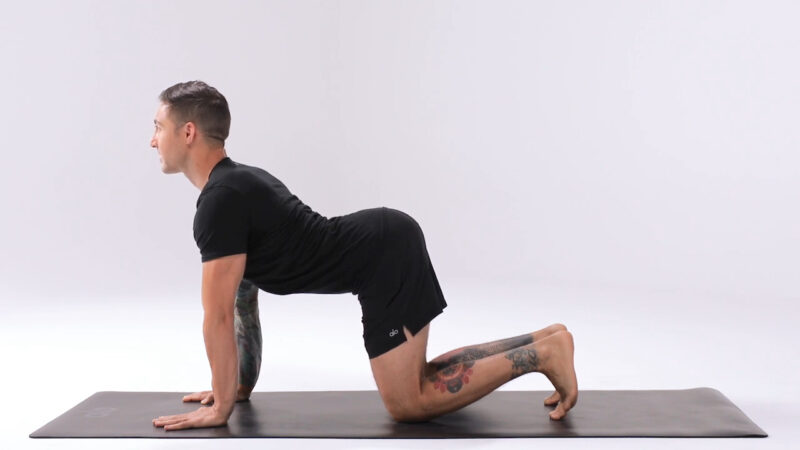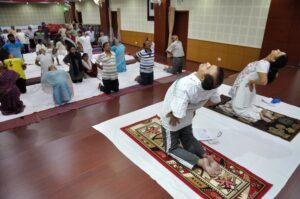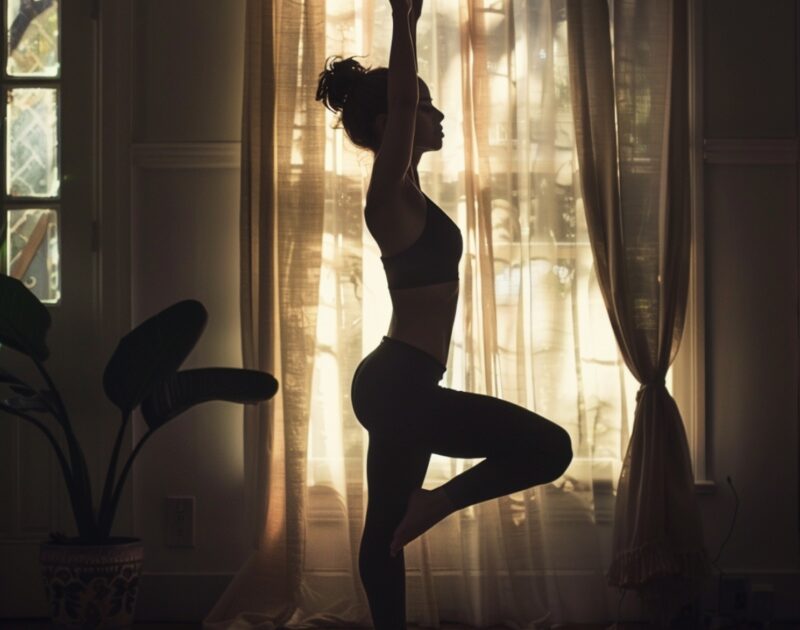There is a saying that you are only as young as your spine is flexible. If that is true, what should and can we minimally do every day to keep our spine as strong, flexible, and healthy as possible? Keeping your spine flexible isn’t just about being able to touch your toes; it’s about keeping your back happy and healthy so you can move around easily. That’s why Yoga Poses for Spinal Flexibility is crucial.
Imagine your spine as the boss of back mobility, helping you bend, twist, and reach. If you keep it in good shape, you’ll feel awesome. Yoga is a great way to make sure your spine stays on point. It’s like a chill session for your back that keeps everything working smoothly.
Let’s check out some yoga moves that are perfect for making your spine as flexible as a rubber band.
21. Bridge Pose
Because it is the last on our Yoga Poses for Spinal Flexibility list, it doesn’t mean it’s not worth it. This backbend primarily utilizes the back muscles, as well as the glutes and hamstrings. It stretches the chest, neck, and spine, relieves tension in the back, and can even help to improve your posture. If you are new to backbend postures, it is a great place to start.
How to do it: Lie on your back with your knees bent and feet hip-width apart. Position your feet as close to your sitting bones as is comfortable and gently hold your ankles with your hands. Inhale, press into your feet and lift your hips and spine off the floor.
If it is more comfortable, you can clasp your hands beneath you instead of holding your ankles. Breathe deeply and hold the position for 2-3 cycles of breath. Exhale as you slowly lower to the ground.
20. Cow Pose (Bitilasana)

Bitilasana (Cow Pose), a backbend, is commonly paired with Marjaryasana (Cat Pose) at the beginning of a vinyasa flow to warm up your body—especially your spine—for other poses. Cow helps relieve tension in your upper body, especially in your back, shoulders, and neck, and it gently massages the spine to increase mobility.
19. Downward Dog
Downward dog, also called downward-facing dog, is a full-body stretch that involves putting your body on all fours (not unlike a dog) and lifting your hips upward while straightening your legs so your body forms an inverted “V” shape. In yoga, it’s used as a resting pose or a transition pose. In physical therapy, it can be used to reduce pain and improve function throughout the body.
| Benefits | |
|---|---|
| Exercise: | Downward dog is a versatile exercise that helps to improve strength, mobility, and flexibility throughout your body in large and small muscles. |
| Useful for: |
|
18. Balasana
Bālāsana or Child Pose, is a kneeling asana in modern yoga as exercise. Balasana is a counter asana for various asanas and is usually practiced before and after Sirsasana.
Child’s Pose isn’t entirely inactive if you take the version with your arms outstretched in front of you, which engages and stretches your back muscles as well as your shoulders and arms. Because Balasana involves compressing the body on the mat or floor, it can be challenging—physically and emotionally. There are multiple variations that can help different bodies relax into the pose.
Steps
- From Table pose, exhale and lower the hips to the heels and forehead to the floor.
- Have the knees together or if more comfortable, spread the knees slightly apart.
- The arms can be overhead with the palms on the floor, the palms or fists can be stacked under the forehead, or the arms can be alongside the body with the palms up.
- If you feel that your knee is hurting or if you are unable to sit on your heels, you can keep a bolster or blanket between your legs and then do the pose.
- Or If the top of the foot is stretching too much then the bolster can be placed just below your feet.
- Remember that this is a restorative calming pose so find what works best for you to relax.
- Breathe slowly and deeply, pressing the belly gently against the thighs on the inhale.
- Breathe and hold for 4-12 breaths.
To release: place the palms under the shoulders and slowly inhale up to a seated position.
Benefits
- Gently stretch your lower back, hips, thighs, knees, and ankles
- Relaxes your spine, shoulders, and neck
- Increases blood circulation to your head
- Massages your internal organs and keeps them supple
- Calms the body, mind, and central nervous system
- Relieves stress, fatigue, and tension
17. Sphinx pose
Sphinx Pose is a gentle backbend suitable for most beginners. It lengthens the abdominal muscles, strengthens the spine, and firms the buttocks. It also stretches and opens the chest, lungs, and shoulders. It invigorates the body, soothes the nervous system, and is also therapeutic for fatigue.
To practice the Sphinx pose, lie on your stomach with your legs extended behind you. Place your forearms on the ground parallel to each other, with your elbows directly under your shoulders. Press your forearms into the ground and lift your chest up, keeping your shoulders relaxed and away from your ears. Hold the pose for several breaths, then release it back down to the ground.
16. Cobra pose
Cobra pose, also known as Bhujangasana in Sanskrit, is a yoga pose that helps to stretch the chest, shoulders, and abdomen while strengthening the spine. It is a backbend pose that can help improve posture and relieve stress.
To perform the Cobra pose, lie on your stomach with your palms flat on the ground under your shoulders. Press into the ground and lift your chest up, keeping your elbows close to your body. Hold the pose for a few breaths before slowly lowering back down.
15. Dhanurasana (Bow Pose)
Difficult one. Dhanurasana is very effective in weight loss programs. It is a basic posture of Hatha yoga. In this exercise, our body pose looks like the shape of the Dhanush (bow). So it is called Dhanurasana in Sanskrit. It helps to reduce belly fat fast. It Strengthens ankles, thighs, groins, chest and abdominal organs, and spinal cord.
There are many parts of the body that can limit a student’s ability to approach Bow Pose (Dhanurasana): tight shoulders, pecs, quads, hip flexors, and/or abs could be the culprit, or weak hamstrings, glutes, and/or back muscles.
14. Extended Triangle pose
Extended Triangle Pose, also known as Utthita Trikonasana in Sanskrit, is a standing yoga pose that helps to stretch and strengthen the entire body. It is a great pose for improving flexibility in the hamstrings, hips, and spine, as well as building strength in the legs and core.
To practice Extended Triangle Pose, start in a wide-legged stance with your feet about 3-4 feet apart. Turn your right foot out 90 degrees and your left foot in slightly. Extend your arms out to the sides at shoulder height, and hinge at the hips to reach your right hand down towards your right foot, while extending your left arm up towards the ceiling. Keep your chest open and gaze up towards your left hand. Hold the pose for a few breaths, then switch sides.
13. Spinal twist
Stretching your back with a twist can reduce pain and improve mobility from your shoulders and thoracic spine all the way down to your lumbar spine, hips, and glutes. “We hold tension in our backs a lot, partly because we have a much more (technology-centered) world,” Leber explains.
12. Camel Pose
Camel Pose, also known as Ustrasana in Sanskrit, is a yoga pose that stretches the front of the body, including the chest, abdomen, and quadriceps. It is a backbend pose that can help improve posture, increase flexibility, and strengthen the back muscles.
To perform Camel Pose, start by kneeling on the floor with your knees hip-width apart. Place your hands on your lower back for support, then slowly arch your back and lean back, reaching your hands towards your heels. Keep your hips aligned over your knees and your neck in a neutral position. Hold the pose for a few breaths before slowly returning to the starting position.

11. Forward Bend (Paschimottanasana)
This pose helps calm the brain and relieve stress. It stretches the spine, shoulders, and hamstrings. To perform this pose, sit with legs extended forward, exhale, and bend forward from the hip joints, reaching for the feet with the hands.
Each of these poses offers specific benefits and can be modified to accommodate different levels of flexibility and experience. Always ensure to warm up properly and consult with a yoga instructor to get the most out of your practice and avoid any potential injuries.
Now it is time for TOP 10 on our Yoga Poses for Spinal Flexibility list.
10. Ardha Matsyendrāsana (Half Lord of the Fishes Pose)
This seated spinal twist increases flexibility in the spine and hips while stimulating the liver and kidneys. You perform it by sitting with legs extended, bending one knee over the opposite leg, then twisting the torso towards the bent knee, using the arms to deepen the twist.
9. Locust Pose (Shalabhasana)
This backbend strengthens the muscles of the spine, buttocks, and backs of the arms and legs, while also stimulating abdominal organs. It is performed by lying face down and then lifting the head, chest, arms, and legs off the floor.
8. Anjaneyasana (Low Lunge)
Anjaneyasana stretches the hip flexors, strengthens the knees, and helps build mental focus. To do this pose, step one foot forward into a lunge, drop the back knee to the floor, and raise the arms up above the head, arching the back slightly.
7. Big Toe Pose (Padangusthasana)
Big Toe Pose strengthens the muscles of the legs and improves flexibility in the hamstrings and calves. It involves standing, bending forward from the hips to reach and hold the big toes with the fingers, and then pulling the upper body closer to the legs.
6. Pigeon Pose (Eka Pada Rajakapotasana)
This is a deep hip opener and also stretches the thighs, groin, and psoas. The pose is performed by bringing one knee forward between your hands and extending the opposite leg straight back on the ground.
5. Puppy Pose (Uttana Shishosana)
Puppy Pose is a cross between Child’s Pose and Downward Facing Dog. It stretches the spine and shoulders and is excellent for relieving stress and tension. You perform it by starting in a tabletop position and stretching your arms forward on the ground while pushing your hips back toward your heels.
4. Chair Pose (Utkatasana)
Chair Pose strengthens the thighs and ankles, while toning the shoulders, butt, hips, and back. It also stimulates the heart and diaphragm. The pose looks like sitting back in an imaginary chair, with the arms extended forward or up above the head.
3. Malasana (Garland Pose)
Malasana helps to stretch the ankles, groins, and back, while toning the abdomen. It involves squatting with feet as close together as possible, with heels on the floor if possible, and the torso leaning forward between the thighs. It is very easy to do, and at the same time so useful for stretching and relaxing your legs. Yoga Squat definitely deserves to be on the Yoga poses for spinal flexibility list.
What to do after Malasana?
Some poses to follow right after Malasana to relax the legs and back are Dandasana (Staff Pose): Soon after completing Malasana, sit on the floor, stretch the legs out completely in front of you, and keep the spine straight. The legs should be loose and the shoulders and the neck relaxed.
2. Tree Pose (Vrikshasana)
Tree Pose focuses on improving balance, stability, and poise. It also strengthens the thighs, calves, ankles, and spine while helping with concentration and calming the mind. The pose is performed by standing on one leg, bending the other knee, and placing the foot of the bent leg on the inner thigh of the standing leg, while the arms are raised above the head.
1. Trikonasana (Triangle Pose)
Our number one of list Yoga Poses for Spinal Flexibility is Trikonasana. It stretches and strengthens the thighs, knees, and ankles, while also stimulating the abdominal organs, improving digestion, and helping to relieve stress. The pose involves extending one leg out to the side, with feet wide apart, and stretching the arms out parallel to the ground, then bending over the leg, reaching towards the foot with one hand and extending the other towards the sky.
It relieves stiffness and enhances the flexibility of the legs especially the back muscles of the thigh (hamstrings). This sideways bending pose may help to elongate the leg muscles to possibly improve the strength of the thighs, calves, and legs.
Yoga Poses for Spinal Flexibility – Make Your Back Feel Awesome
Giving your back some yoga love every day can really boost how bendy and strong it feels. Each move helps your spine in its own special way. Stick with these poses and your back won’t hurt as much. Plus, yoga is totally relaxing AND helps you feel better. Not sure how to do the poses?
Taking a class can show you the right way. These moves will transform how your back feels and even lift your mood. Are you ready to dive in and see for yourself?
Doing yoga regularly can really help your back be more flexible. It can cut down on any aches too. The poses will also help you stand up straighter and feel taller. Each one targets your spine in a unique way to make it feel brand new. Keep doing yoga and you’ll see what your back is capable of without pain.
Practicing yoga is also a chill way to take care of your body while relaxing. It’s a win-win! If you feel unsure about trying poses on your own, signing up for a class is smart. The teacher can guide you through the proper form.
So what are you waiting for? Give these poses a try and see how they change up your back and mood for the better. You’ll be amazed at the transformation. Feel free to ask me any questions as you get started too – I’m here to help!
As a physical education teacher and a mom, I believe that fitness should be fun and accessible. I love introducing new sports and activities to my students and showing them how to stay active and healthy. When I’m not teaching, you might find me planning my next outdoor adventure or experimenting with healthy recipes. I believe in flexibility and think it’s a big deal when it comes to staying fit. That’s why I always make sure to start and end my workouts with a good warm-up and cool-down to avoid getting hurt. I mix things up with both dynamic and static stretching, and lately, I’ve been getting into yoga which is great for building muscle strength and flexibility.

